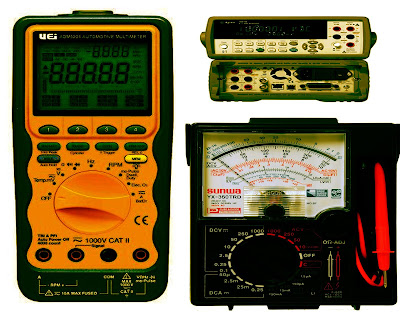Multimeter is a multi-purpose electronic measuring instruments, mainly used to measure the field of physical, electrical, electronic, etc., generally contain ammeter (ammeter), a voltage meter (voltmeter), resistance meter (ohmmeter) and other functions , also known as universal design, multi-meter, multimeters, multimeter or multimeter.
Pointer multimeter known as VOM (Volt-Ohm meter, volt - ohm meter) in English, but this name is not usually used for digital multimeter.
Multimeter with a portable device used for basic troubleshooting, but also a desktop device is placed in a factory or laboratory workbench.
Some meter resolution can reach seven or eight digits; such a device, it often occurs in the laboratory is used as a reference voltage or resistance, or to adjust the standard multi-function performance.
Basic measurement functions:
Current, voltage and resistance measurements, generally regarded as the universal plan of basic functions. Early multimeter manufacturers AVO brand name of these three is the unit of measurement device capable of measuring the abbreviation: Ampere (Ampere), V (Volt), ohms (Ohm)
Generally we have a basic multimeter measurement functions:
DC voltage (DCV)
DC current (DCmA, DCA)
AC voltage (ACV)
Resistance (Ω, KΩ, MΩ)
AC current (ACmA, ACA) not all multimeters have, especially low-level multimeter.
Pointers and digital multimeter:
Pointer multimeter, using a magnetic field deflecting pointer dial, this watch head and the same classic galvanometer; digital multimeter is used to display LCD, vacuum fluorescent display (VFD), LED, OLED, etc. In addition, it also uses digital tube early.
Pointer multimeter on the new and second-hand market are hard to find. But because zero and accurate readings from the instrument panel are prone to error, and difficult to scale subdivision restrictions in accuracy and resolution are not as digital meters. And the digital meter voltage profile with a high input impedance, and can immediately read the number, the pointer meter unless there are marked directly refers to the value of large-scale , It shall be observed and counted within the meaning of the small-scale relations with neighboring large measure, it read really value. However, in some cases, such as speed of response header, easy to quickly outline that value, or the value of the response in terms of jitter, etc., remain some of the advantages, and the internal circuit is simple, easy to learn measuring circuit theory, therefore, part of the some situations or circumstances are still in use. In addition, some digital meters have reacted faster than the number of changes strip show, emulate pointer effects to quickly grasp the changes in the value of the benefit.
In order to improve pointer multimeter input impedance voltage profile and reduce the impact of treatment of the circuit under test, and some high-end pointer multimeter uses vacuum tubes to amplify the input signal, this design is also known as vacuum multimeter voltmeter (VTVM, Vacuum Tube Volt Meters) or vacuum multimeter (VTMM, Vacuum Tube Multimeters). Such as the use FET to amplify the input signal, it is FETVM.
Digital multimeter with digital meter based and is specifically called a digital multimeter (DMM, Digital MultiMeter). In this device, the measured signal is converted into a digital voltage and digital pre-amplifier, and then by the digital display directly display the value; thus avoiding parallax when reading the error caused.
Similarly, better systems and electronic circuit technology, but also to improve the measurement accuracy. General basic accuracy pointer instrument (DC voltage range) between 2% to 5%, the common basic accuracy of 3 to 4%. Digital portable digital multimeter common portable type basic accuracy of 0.5% to 1%, advanced models, it can reach ± 0.025%, and the table device as much as one millionth of accuracy.
